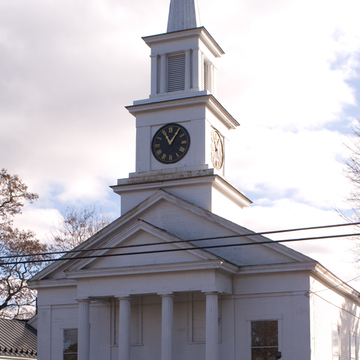This third home of the Congregationalists in Newbury village is an elegant, if conservative, version of the Greek Revival that dominated Vermont building in the mid-nineteenth century. In 1840 the church membership decided to move from the town-owned meetinghouse of 1788, precipitating its sale eight years later to the Connecticut and Passummpsic Rivers Railroad for use as a depot, and its demise as it broke loose and crashed while being moved to its intended new location. Compounding the architectural disaster, their new building, on the site of the present church, burned in January 1856. That summer, master builder Archibald Mills, who was also responsible for the church in West Newbury, undertook its replacement.
The church's essentially Federal composition of body, porch, and tower is recast into spare Greek terms. A columnar portico and a pediment that echoes the slope of the main roof step forward from a matchboarded facade crowned by a tower that rises in stages from a square base to a square belfry with Doric columns, and a crowning spire. Its features are similar to those of a series of churches built downriver in Plainfield and Cornish Center, New Hampshire, in the 1840s and attributed to Charles Egglestone. This and the overall massing indicate Mills's use of regional and traditional sources. However, the refined proportions and the coordination and integration of the elements also indicate that Mills was a sensitive designer and highly skilled builder.











